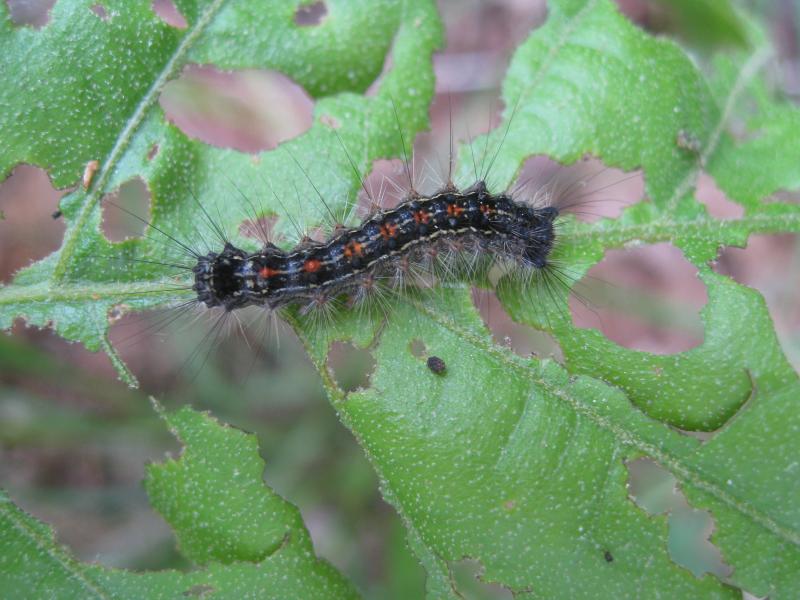More skin rashes, deforestation predicted from gypsy moth overpopulation
Though many people are tiring of the dreary weather, it is good news for reducing New England’s gypsy moth caterpillar population, which is projected to decline this season.
After three dry spring seasons that built up an unusually large gypsy moth population, this year’s cool, damp weather has cultivated a fungus, entomophaga maimaiga, that is deadly to gypsy moth caterpillars.
The Massachusetts Department of Conservation and Recreation aerially mapped approximately 350,000 acres of defoliation across Massachusetts in 2016, attributed to the high population of gypsy moths. The Massachusetts Government’s Energy and Environmental Affairs office predicted more deforestation for this year.
Although currently there are many gypsy moth caterpillars around at the same size as they were last year, experts are expecting their numbers to greatly decrease this year as the fungal disease is spread between caterpillars.
“This year with the wet weather, the caterpillars will probably die before they’re even full size,” said Heather Faubert, a research associate at the University of Rhode Island. She added that it is not yet known at what point in their life cycle the caterpillar population will be back to normal.
Some Wareham residents have taken drastic measures to eradicate the caterpillars from their yards, as the caterpillars ravage trees and can lead to devastating deforestation, preferring oak, maple, birch, poplar and apple trees.
“When they’re up in the trees and they’re pooping on your head, it seems to be the end of the world,” said Martha Sylvia, a research technician at UMass Cranberry Station.
Sandy Slavin, a member of the Wareham Garden Club, said her trees were damaged by the caterpillars last year, so this spring she collected their egg masses and used an oil on them to make sure they would not hatch.
When Slavin had a problem with gypsy moth caterpillars years ago, she had another inventive measure to get rid of them. She made a trap for the moths, putting burlap around the base of trees and putting duct tape around the tree with the sticky side facing up. When the caterpillars fell to the ground, they would get stuck in the tape and be unable to get back into the tree.
“Every evening I would go around and hit them with a rubber hammer,” Slavin said.
This year, Fauber said “Mother Nature is doing a wonderful job all by herself,” of reducing the caterpillar population.
Ian Dadour, a professor of forensic entomology at Boston University, disagreed with this optimistic prediction.
“It is here to stay,” said Dadour, who estimates the gypsy moths affect more than 500 species of shrubs and trees. “If you thought you had a problem this year, it’s going to get get bigger next year.”
Dadour recommended buying chemicals from the store to treat trees with and banding trees with sticky paper to prevent caterpillars from climbing them.
The damp weather is also good for the trees, according to Kevin Moran, a technical representative at Forshaw and a member of the Entomological Society of America.
Moran said even if there is defoliation, the trees should be healthier when they put out a second set of leaves later this summer.
Typically, landscapers and arborists are key players in controlling gypsy moths, Moran said, but when they are “overwhelmed, which they are now,” pest management gets involved. The chemicals used on trees are less toxic to the environment than in the past, but Moran said they also do not last as long. Two treatments are now needed to keep the trees healthy.
Moran said though the caterpillars are slowed, people should not grow complacent in managing them. Homeowners only have another week or two to act before it is too late to stop defoliation on their trees.
“I’m afraid in many cases [the gypsy moths] have just been slowed down and once we get this warmer weather like the week coming up, we will see quick defoliation,” Moran said.
Gypsy moths first came to the northeastern United States in 1906 from Europe and Asia, according to Sylvia.
“The trouble is, when you start to grow species of tree that shouldn’t be grown here, along come their pests as well,” Dadour said.
There are years where they are abundant and years where they are less of a problem. This year, Sylvia said cranberry growers have sprayed their crops twice to protect them.
“Because of the crummy weather, we’ve had good luck that they're dying off,” Sylvia said.
The gypsy moth caterpillars, still numerous this year, as the fungus has not yet killed them, have been an inconvenience already. Some deforestation is expected and some people have reported getting rashes from the caterpillar hairs.
“A lot of rashes were happening a few weeks ago when the caterpillars were blowing around a lot,” Faubert said. She got a rash from the caterpillars for the first time this year.
The general public is more concerned with this skin rash than deforestation, Dadour said.
“They only become aware of these things when it affects their skin or when it affects them personally,” Dadour said.
Other problems the caterpillars introduce are how easily they are transported. They can move to different areas on a person’s car or clothes, Slavin said, which can then affect the whole area.
Dadour said this often happens when people go camping in an area with a larger population of gypsy moth caterpillars, like in northern Massachusetts. Then, they return to the south of the state and can bring caterpillars back in their sleeping bags or tents, increasing the population in this area.
Ultimately, gypsy moths are “extremely adaptable,” Dadour said. This year may reduce their population because of the weather, but some experts maintain Massachusetts has not seen the last of them.
"The caterpillars are there," Moran said. "They’re waiting for better weather, and they will consume leaves very rapidly when the temperatures get back to normal."















